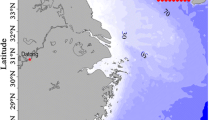Abstract
Temperature data collected in the sections of 34°N, 35°N and 36°N in August from 1975 through 2003 were analyzed using Empirical Orthogonal Function (EOF) to investigate interannual variability of the southern Yellow Sea Cold Water Mass (YSCWM). The first mode (EOF1) reveals variations of basin-wide thermocline depth, which is mainly caused by surface heating. The second mode (EOF2) presents fluctuations of vertical circulation, resulting mainly from interannual variability of cold front intensity. In addition, it is found that the upward extent of upwelling in the cold front is basically determined by wind stress curl and the zonal position of the warm water center in the southern Yellow Sea is correlated with spatial difference of net heat flux.
Similar content being viewed by others
References
Feng, M., D. Hu and Y. Li, 1992. A theoretical solution for the thermocline circulation in the Southern Yellow Sea.Chin. J. Oceanol. Limnol. 10(4): 289–300.
Guan, B., 1963. A preliminary study of the variation of the temperature and the characteristics of the circulation of the Yellow Sea Cold Water Mass.Oceanol. et Limnol. Sin. 5(4): 255–284. (in Chinese with English abstract)
He, C., Y. Wang, Z. Lei and S. Xu, 1959. Preliminary study of the formation of Yellow Sea Cold Water Mass and its property.Oceanol. et Limnol. Sin. 2(1): 11–15. (in Chinese with English abstract)
Hu, D., M. Cui, Y. Li and T. Qu, 1991. On the Yellow Sea Cold Water Mass related circulation.Yellow Sea Research 4: 79–88.
Hu, D., 1994. Some striking features of circulation in the Huanghai Sea and East China Sea.In: Zhou, D., Y. B. Liang and C. K. Tseng, eds, Oceanology of China seas, Vol. 1, Kluwer Academic Publishers, p: 27–38.
Jia, R., and L. Sun, 2002. Distribution Features of the Yellow and Bohai Seas Temperature in Winter and Summer,Marine Science Bulletin 21(4): 1–8. (in Chinese with English abstract).
Lee, Y., Y. Qin and R. Liu (ed.), 1998. Yellow Sea Atlas. Ho Yong Publishing Co., 524p.
Li, K., 1991. Response of the Yellow Sea Cold Water Mass to ocean variation.Acta Oceanol. Sin. 13(6): 779–785. (in Chinese)
Mao, H., Y. Ren and G. Wan, 1964. A preliminary investigation on the application of using T-S diagrams for a quantitative analysis of the water masses in the shallow water area.Oceanol. et Limnol. Sin. 6(1): 19–20. (in Chinese with English abstract)
Miao, J., 1984. A simple model for the thermal structure of Kuroshio east of Taiwan.Oceanol. et Limnol. Sin. 15(6): 558–567. (in Chinese with English abstract)
Preisendorfer, R. W., 1988. Principal Component Analysis in Meteorology and Oceanography. Developments in Atmospheric Science, Vol. 17. Elsevier, New York.
Su, J. and D. Huang, 1995. The circulation structure of Yellow Sea Cold Water Mass,Oceanol. et Limnol. Sin. suppl.26(5): 1–7. (in Chinese with English abstract)
Weng, X. and C. Wang, 1982. Determination of the boundary and T-S bounds of the Huanghai Sea Cold Water Mass.In: Proceeding of the 1980 Symposium on Hydrometeorology of the Chinese Society of Oceanology and Limnology. p. 61–70. (in Chinese with English abstract)
Uda, M., 1934. Hydrographical researches on the normal monthly conditions in the Japan Sea, the Yellow Sea, and the Okhotsk Sea.J. Imp. Fish. Exp. Sta. 5: 191–236. (in Japanese)
Yuan, Y., 1979. A preliminary study on the circulation related to the cold water mass of the Yellow Sea. I. Thermal structure and the characteristics of the circulation in the central part of the cold watermass.Oceanol. et Limnol. Sin. 10(3): 187–199. (in Chinese with English abstract).
Yuan, Y. and H. Li, 1993. Study on the circulation structure and formation mechanism of the Yellow Sea Cold Water Mass. I.Science in China (Series B).23(1): 93–103. (in Chinese)
Zhang, Q., X. Weng and Y. Yang, 1996. Analysis of water masses in the south Yellow Sea in spring.Oceanol. et Limnol. Sin. 27(4): 421–428. (in Chinese with English abstract)
Zhang, Y. and Y. Yang, 1996. Analyses of the variational characteristics of the north Huanghai Sea Cold Water Mass.Marine Forecasts 13(4): 15–21. (in Chinese with English abstract)
Zhao, B., 1987. A preliminary study of continental shelf fronts in the western part of southern Huanghai Sea and circulation structure in the front region of the Huanghai Cold Water Mass (HCWM).Oceanol. et Limnol. Sin. 18(3): 217–226. (in Chinese with English abstract)
Zou, E., B. Xu, Z. Wang and Q. Liao, 2001. Spatial and temporal variations in the characteristics of the intermediate cold water in the west of the southern Yellow Sea.Journal of Oceanography of Huanghai & Bohai Seas 19(2): 10–16. (in Chinese with English abstract)
Author information
Authors and Affiliations
Additional information
Contribution No.4612 from the Institute of Oceanology, Chinese Academy of Sciences, Qingdao, China
Supported by the National Basic Research Program of China (No. G1999043803)
Rights and permissions
About this article
Cite this article
Dunxin, H., Qingye, W. Interannual variability of the southern Yellow Sea Cold Water Mass. Chin. J. Ocean. Limnol. 22, 231–236 (2004). https://doi.org/10.1007/BF02842553
Received:
Accepted:
Issue Date:
DOI: https://doi.org/10.1007/BF02842553



